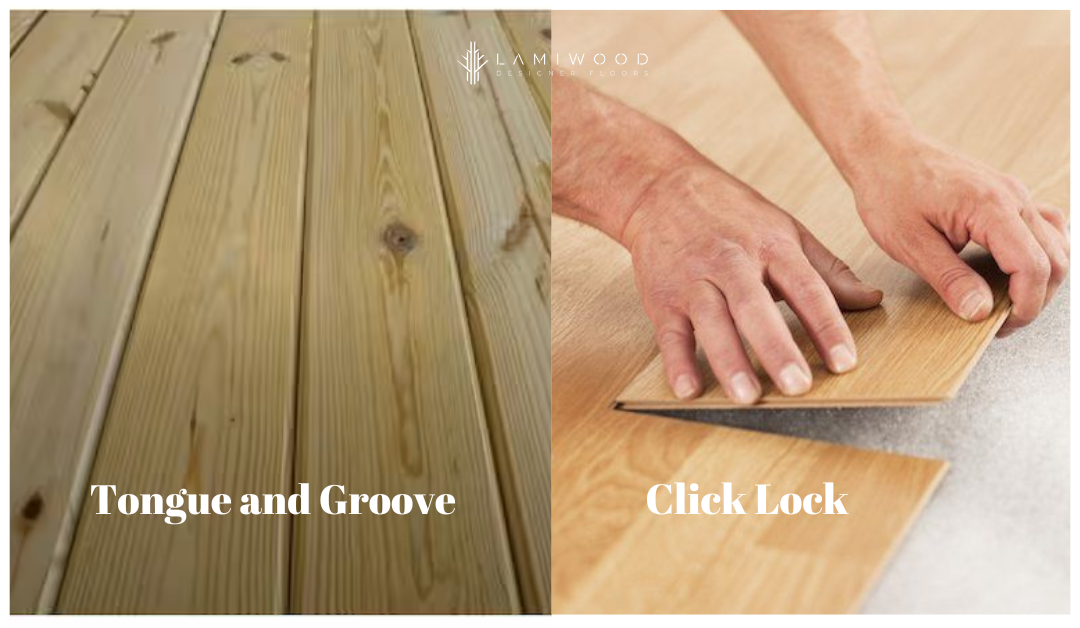Flooring is not just a functional aspect of our living spaces; it’s an essential component that adds character, style, and durability to our homes. When it comes to choosing the right type of Wooden flooring, the options can be overwhelming. Among the popular choices are tongue and groove and click lock flooring systems. Understanding the differences between these two can help you make an informed decision for your space. So, let’s delve into the intricacies of tongue and groove versus click-lock flooring to find out which one suits your needs best.
Tongue and Groove Flooring:
Tongue and groove flooring is a traditional method of fitting floorboards together. The design consists of one side (the tongue) of the board fitting into a groove on the adjacent board. This interlocking system creates a tight, seamless fit, preventing gaps and ensuring stability.
Advantages of Tongue and Groove Flooring:
- Stability: The interlocking mechanism of tongue and groove flooring provides excellent stability, reducing the chances of warping or shifting over time.
- Durability: This flooring type is known for its durability, making it suitable for high-traffic areas in residential and commercial spaces.
- Installation: Tongue and groove flooring can be installed using either the nail-down or glue-down method, offering flexibility based on your preferences and the subfloor conditions.
- Traditional Aesthetic: For those seeking a classic, timeless look, tongue and groove flooring adds a touch of traditional charm to any space.
Drawbacks of Tongue and Groove Flooring:
- Professional Installation: While tongue and groove flooring can be installed by experienced DIYers, achieving a flawless finish often requires professional installation, which can increase overall costs.
- Limited Flexibility: Once installed, tongue and groove flooring is challenging to remove or replace without causing damage to the surrounding boards.
Click Lock Flooring:
Click lock flooring, or “floating flooring,” is a modern alternative to traditional tongue and groove systems. Instead of using nails or adhesives, click-lock flooring features planks that snap together using a locking mechanism along the edges.
Advantages of Click Lock Flooring:
- Easy Installation: One of the biggest advantages of click lock flooring is its ease of installation. With no need for nails or glue, even novice DIYers can achieve professional-looking results in a fraction of the time.
- Versatility: Click lock flooring can be installed over almost any existing subfloor, including concrete, plywood, or existing flooring, making it a versatile option for renovation projects.
- Cost-Effective: Since click lock flooring is easier and quicker to install, it often results in lower installation costs compared to tongue and groove flooring.
- Disassembly: Click lock flooring is designed for easy disassembly, allowing for straightforward repairs or replacement of individual planks if necessary.
Drawbacks of Click Lock Flooring:
- Stability: While click lock flooring offers stability once installed, it may not be as secure as tongue and groove flooring, especially in high-moisture environments.
- Subfloor Preparation: While click lock flooring can be installed over various subfloors, ensuring a level and clean surface is crucial to prevent issues such as unevenness or squeaking.
Choosing the Right Flooring for Your Space:
When deciding between tongue and groove and click lock flooring, several factors should be considered:
- Budget: Determine your budget for materials and installation, considering any additional costs such as underlayment or subfloor preparation.
- Location: Consider the location of the installation area, including the level of foot traffic and exposure to moisture.
- Aesthetic Preferences: Think about the aesthetic you want to achieve in your space, whether it’s a classic, traditional look or a more modern, sleek appearance.
- Installation Expertise: Assess your level of experience and comfort with DIY projects, as well as your willingness to hire professionals for installation if necessary.
Conclusion:
Both tongue and groove and click lock flooring systems offer unique advantages and considerations. Tongue and groove flooring provides stability and a timeless aesthetic, while click lock flooring offers easy installation and versatility. By understanding the differences between these two options and considering your specific needs and preferences, you can make an informed decision that enhances the beauty and functionality of your living space. Whether you opt for the classic appeal of tongue and groove or the modern convenience of click lock, investing in quality flooring is an investment in the long-term comfort and value of your home.

